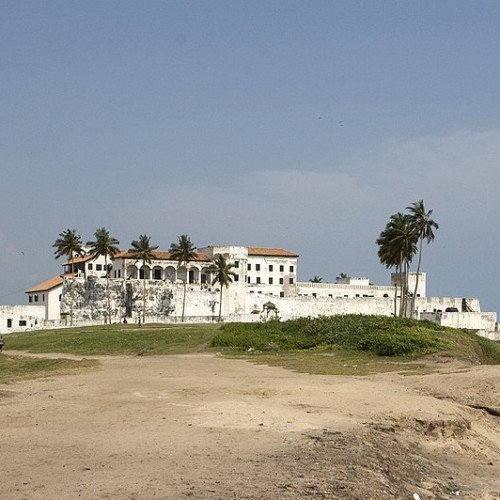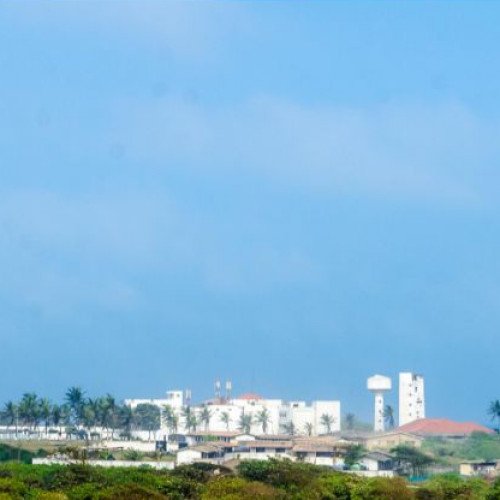Castles of "Ghana" ELMINA CASTLE vs OSU CASTLE

ELMINA CASTLE
Elmina Castle was erected by the Portuguese in 1482 as Castelo de São Jorge da Mina (St. George of the Mine Castle), also known as Castelo da Mina or simply Mina (or Feitoria da Mina), in present-day Elmina, Ghana (formerly the Gold Coast). It was the first trading post built on the Gulf of Guinea, and the oldest European building in existence south of the Sahara. First established as a trade settlement, the castle later became one of the most important stops on the route of the Atlantic slave trade. The Dutch seized the fort from the Portuguese in 1637, after an unsuccessful attempt to the same extent in 1596, and took over all of the Portuguese Gold Coast in 1642. The slave trade continued under the Dutch until 1814. In 1872, the Dutch Gold Coast, including the fort, became a possession of Great Britain. The Gold Coast, which is now Ghana, gained its independence in 1957 from Britain, and had control of the castle. Elmina Castle is a historical site, and was a major filming location for Werner Herzog's 1987 drama film Cobra Verde. The castle is recognized by UNESCO as a World Heritage Site. The people living along the West African coast at Elmina around the fifteenth century were presumably Fante. The Fante ethnicity bears an uncertain relationship to "Akan," itself a word connoting originality from the root word, "kan", to be first or original. Among their ancestors were merchants and miners trading gold into the Mediterranean and Near Eastern worlds from medieval times. The ancestors of the Akan-speakers of the forests however undoubtedly came from north of the forest. The people on the West African coast were organized into numerous populations that were drawn according to kinship lines. Family was extremely important in society, and family heads were united in communities under a recognized local authority. Along the Gold Coast alone, more than twenty independent kingdom-states existed. Elmina lay between two different Fante kingdoms, Fetu and Eguafo. West Africans nurtured ancient connections to other parts of the world. Common metals trade, iconic artistic forms, and agricultural borrowing show that trans-Saharan and regional coastal connections thrived. The Portuguese in 1471 were the first Europeans to visit the Gold Coast as such, but not necessarily the first sailors to reach the port.
Statistics for this Xoptio

OSU CASTLE
Osu Castle, also known as Fort Christiansborg or simply the Castle, is a castle located in Osu, Accra, Ghana on the coast of the Atlantic Ocean's Gulf of Guinea. The first substantial fort was built by Denmark-Norway in the 1660s, though the castle has changed hands between Denmark-Norway, Portugal, the Akwamu, Britain, and finally post-Independence Ghana, and was rebuilt numerous times. For most of the castle's history, it has been the seat of government in Ghana with some interruptions, the latest when the John Kufuor administration moved the seat of government to Golden Jubilee House after 6 January 2009, which was quickly reversed by the incoming John Atta Mills administration. It also serves as the place where the late president of Ghana John Atta Mills is buried; in a bird sanctuary, overlooking the Atlantic Ocean. The area was first occupied in 1550 by the Portuguese, though in the 17th century Portuguese influence diminished. The area came under the control of Sweden in the 1650s, led by the Dutch trader Hendrik Carloff. In 1652, he was given permission to build a small fortified lodge by the King of Accra, with whom he had previously done business. In 1660, control passed to the Netherlands but it was soon lost to Denmark-Norway. In 1657, Carloff had again traveled to Africa, this time representing Denmark-Norway. He aimed to conquer the forts he had previously established, which he found easy at Osu. In its early life, the castle was primarily used in the gold and ivory trade, but under Dano-Norwegian control it increasingly dealt with slaves. Entrance to Fort Christiansborg after it was opened to the public in 2017. Osu Castle was located close to two other forts. Fort Crèvecœur was controlled by the Dutch and Fort James by the British. The settlement at Osu was too small to store sufficient goods to compete with the others. Consequently, Denmark-Norway purchased adjoining land and expanded the building, naming it Fort Christiansborg after the reigning Danish King Christian V of Denmark-Norway. This is not to be confused with the slightly later royal palace in Copenhagen. Denmark-Norway would occupy the fort for most of the next 200 years, with some interruptions, and for much of that time it served as the capital of the Gold Coast of Denmark-Norway.